- Clone
- SB/199 (See other available formats)
- Regulatory Status
- RUO
- Other Names
- IL-7 receptor α chain, IL-7Rα
- Isotype
- Rat IgG2b, κ
- Ave. Rating
- Submit a Review
- Product Citations
- publications

-

C57BL/6 splenocytes stained with SB/199 biotin followed by Sav-PE and CD3 (145-C11) FITC
| Cat # | Size | Price | Quantity Check Availability | Save | ||
|---|---|---|---|---|---|---|
| 121103 | 50 µg | £73 | ||||
| 121104 | 500 µg | £282 | ||||
CD127 is a 60-90 kD type I transmembrane glycoprotein, also known as IL-7 receptor α chain or IL-7Rα. It forms heterodimer with the common γ chain (γc or CD132) which is shared with the receptors for IL-2, IL-4, IL-9, IL-13, IL-15, and IL-21. CD127 is expressed on immature B cells through early pre-B stage, thymocytes (except CD4/CD8 double positive thymocytes), peripheral T cells, and bone marrow stromal cells. CD127 has been reported to be an useful marker for identifying memory and effector T cells. The ligation of IL-7 with its receptor is important for stimulation of mature and immature T cells as well as immature B cells proliferation and development.
Product DetailsProduct Details
- Verified Reactivity
- Mouse
- Antibody Type
- Monoclonal
- Host Species
- Rat
- Immunogen
- Mouse pre-B cell line 1A9
- Formulation
- Phosphate-buffered solution, pH 7.2, containing 0.09% sodium azide.
- Preparation
- The antibody was purified by affinity chromatography, and conjugated with biotin under optimal conditions.
- Concentration
- 0.5 mg/ml
- Storage & Handling
- The antibody solution should be stored undiluted between 2°C and 8°C. Do not freeze.
- Application
-
FC - Quality tested
- Recommended Usage
-
Each lot of this antibody is quality control tested by immunofluorescent staining with flow cytometric analysis. For flow cytometric staining, the suggested use of this reagent is ≤0.25 µg per million cells in 100 µl volume. It is recommended that the reagent be titrated for optimal performance for each application.
- Application Notes
-
Additional reported applications (for the relevant formats) include: To reduce non-specific binding to cells bearing Fc-receptors, pre-incubation of cells with anti-mouse CD16/CD32, clone 93 (Cat. No. 101301/101302), is recommended prior to immunofluorescent staining.
-
Application References
(PubMed link indicates BioLegend citation) -
- Yamashita Y, et al. 1999. J. Immunol. 162:5940.
- Kouro T, et al. 2002. Blood 100:3672.
- Maeda K, et al. 2005. Blood 106:879.
- Diao J, et al. 2004. J. Immunol. 173:1826.
- Product Citations
-
- RRID
-
AB_493501 (BioLegend Cat. No. 121103)
AB_493502 (BioLegend Cat. No. 121104)
Antigen Details
- Structure
- Type I transmembrane glycoprotein, associate with CD132, 60-90 kD
- Distribution
-
Immature B cells through early pre-B stage, thymocytes (except CD4/CD8 double positive thymocytes), peripheral T cells, bone marrow stromal cells
- Function
- T cell and immature B cell proliferation and development
- Ligand/Receptor
- IL-7
- Cell Type
- B cells, T cells, Thymocytes, Tregs
- Biology Area
- Immunology
- Molecular Family
- CD Molecules, Cytokine/Chemokine Receptors
- Antigen References
-
1. Sudo T, et al. 1993. Proc. Natl. Acad. Sci. USA. 90:9125.
2. He YW and Malek TR. 1998. Crit Rev. Immunol. 18:503.
3. Huster K M,et al. 2004. Proc. Natl. Acad. Sci. USA. 101:5610.
4. Pillai M, et al. 2004. Leuk Lymphoma. 45:2403.
5. Morrissey PJ, et al. 1989. J. Exp. Med. 169:707. - Gene ID
- 16197 View all products for this Gene ID
- UniProt
- View information about CD127 on UniProt.org
Related FAQs
- How many biotin molecules are per antibody structure?
- We don't routinely measure the number of biotins with our antibody products but the number of biotin molecules range from 3-6 molecules per antibody.
Other Formats
View All CD127 Reagents Request Custom Conjugation| Description | Clone | Applications |
|---|---|---|
| Purified anti-mouse CD127 (IL-7Rα) | SB/199 | FC |
| Biotin anti-mouse CD127 (IL-7Rα) | SB/199 | FC |
| FITC anti-mouse CD127 (IL-7Rα) | SB/199 | FC |
| Alexa Fluor® 488 anti-mouse CD127 (IL-7Rα) | SB/199 | FC |
| PE anti-mouse CD127 (IL-7Rα) | SB/199 | FC |
| PerCP/Cyanine5.5 anti-mouse CD127 (IL-7Rα) | SB/199 | FC |
| APC anti-mouse CD127 (IL-7Rα) | SB/199 | FC |
| PE/Cyanine7 anti-mouse CD127 (IL-7Rα) | SB/199 | FC |
| PE/Cyanine5 anti-mouse CD127 (IL-7Rα) | SB/199 | FC |
| Brilliant Violet 711™ anti-mouse CD127 (IL-7Rα) | SB/199 | FC |
Compare Data Across All Formats
This data display is provided for general comparisons between formats.
Your actual data may vary due to variations in samples, target cells, instruments and their settings, staining conditions, and other factors.
If you need assistance with selecting the best format contact our expert technical support team.
-
Purified anti-mouse CD127 (IL-7Rα)
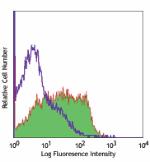
C57BL/6 mouse splenocytes stained with purified SB/199, foll... -
Biotin anti-mouse CD127 (IL-7Rα)
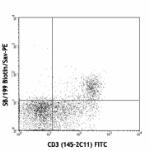
C57BL/6 splenocytes stained with SB/199 biotin followed by S... -
FITC anti-mouse CD127 (IL-7Rα)
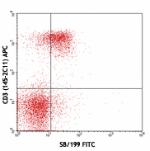
C57BL/6 mouse splenocytes stained with CD3 (145-2C11 APC) an... -
Alexa Fluor® 488 anti-mouse CD127 (IL-7Rα)

C57BL/6 mouse splenocytes stained with CD3 APC and SB/199 Al... -
PE anti-mouse CD127 (IL-7Rα)

C57BL/6 mouse splenocytes stained with CD3 FITC and SB/199 P... 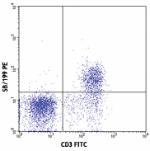
C57BL/6 mouse splenocytes stained with CD3 FITC and SB/199 P... -
PerCP/Cyanine5.5 anti-mouse CD127 (IL-7Rα)

C57BL/6 mouse splenocytes were stained with CD3 APC and CD12... -
APC anti-mouse CD127 (IL-7Rα)
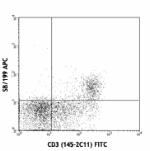
C57BL/6 splenocytes stained with SB/199 APC and CD3 (145-2C1... -
PE/Cyanine7 anti-mouse CD127 (IL-7Rα)

C57BL/6 splenocytes stained with mouse CD127 (IL-7ra) (clone... -
PE/Cyanine5 anti-mouse CD127 (IL-7Rα)

C57BL/6 splenocytes stained with mouse CD127 (IL-7Ra) (clone... -
Brilliant Violet 711™ anti-mouse CD127 (IL-7Rα)

C57BL/6 mouse splenocytes were stained with anti-mouse CD3 F...
 Login / Register
Login / Register 










Follow Us